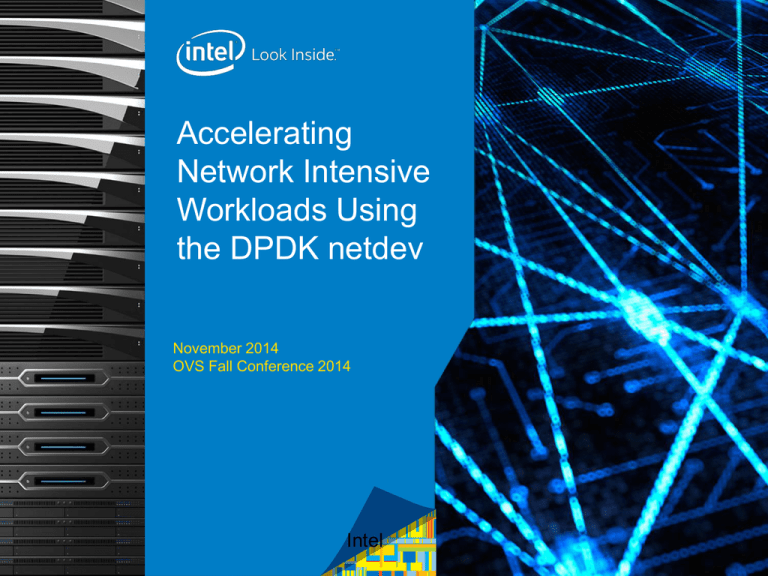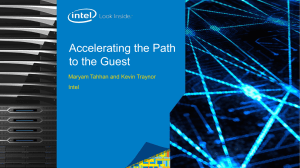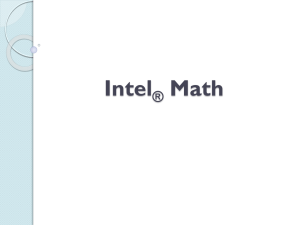
Accelerating
Network Intensive
Workloads Using
the DPDK netdev
November 2014
OVS Fall Conference 2014
Intel
Legal Disclaimers
INFORMATION IN THIS DOCUMENT IS PROVIDED IN CONNECTION WITH INTEL PRODUCTS. NO LICENSE, EXPRESS OR IMPLIED,
BY ESTOPPEL OR OTHERWISE, TO ANY INTELLECTUAL PROPERTY RIGHTS IS GRANTED BY THIS DOCUMENT. EXCEPT AS
PROVIDED IN INTEL'S TERMS AND CONDITIONS OF SALE FOR SUCH PRODUCTS, INTEL ASSUMES NO LIABILITY WHATSOEVER
AND INTEL DISCLAIMS ANY EXPRESS OR IMPLIED WARRANTY, RELATING TO SALE AND/OR USE OF INTEL PRODUCTS
INCLUDING LIABILITY OR WARRANTIES RELATING TO FITNESS FOR A PARTICULAR PURPOSE, MERCHANTABILITY, OR
INFRINGEMENT OF ANY PATENT, COPYRIGHT OR OTHER INTELLECTUAL PROPERTY RIGHT.
A "Mission Critical Application" is any application in which failure of the Intel Product could result, directly or indirectly, in personal injury or
death. SHOULD YOU PURCHASE OR USE INTEL'S PRODUCTS FOR ANY SUCH MISSION CRITICAL APPLICATION, YOU SHALL
INDEMNIFY AND HOLD INTEL AND ITS SUBSIDIARIES, SUBCONTRACTORS AND AFFILIATES, AND THE DIRECTORS, OFFICERS,
AND EMPLOYEES OF EACH, HARMLESS AGAINST ALL CLAIMS COSTS, DAMAGES, AND EXPENSES AND REASONABLE
ATTORNEYS' FEES ARISING OUT OF, DIRECTLY OR INDIRECTLY, ANY CLAIM OF PRODUCT LIABILITY, PERSONAL INJURY, OR
DEATH ARISING IN ANY WAY OUT OF SUCH MISSION CRITICAL APPLICATION, WHETHER OR NOT INTEL OR ITS
SUBCONTRACTOR WAS NEGLIGENT IN THE DESIGN, MANUFACTURE, OR WARNING OF THE INTEL PRODUCT OR ANY OF ITS
PARTS.
Intel may make changes to specifications and product descriptions at any time, without notice. Designers must not rely on the absence or
characteristics of any features or instructions marked "reserved" or "undefined". Intel reserves these for future definition and shall have no
responsibility whatsoever for conflicts or incompatibilities arising from future changes to them. The information here is subject to change
without notice. Do not finalize a design with this information.
The products described in this document may contain design defects or errors known as errata which may cause the product to deviate from
published specifications. Current characterized errata are available on request.
Contact your local Intel sales office or your distributor to obtain the latest specifications and before placing your product order.
Copies of documents which have an order number and are referenced in this document, or other Intel literature, may be obtained by calling
1-800-548-4725, or go to: http://www.intel.com/design/literature.htm
Intel processor numbers are not a measure of performance. Processor numbers differentiate features within each processor family, not
across different processor families: Go to: Learn About Intel® Processor Numbers
Intel, the Intel logo, Intel Atom, and Xeon are trademarks of Intel Corporation in the U.S. and/or other countries.
*Other names and brands may be claimed as the property of others.
Copyright © 2013 Intel Corporation. All rights reserved
2
TRANSFORMING NETWORKING & STORAGE
Agenda
•
•
•
•
Motivation
Architecture
Results
Futures
Motivation
15,000,000
Open vSwitch Phy-Phy
Throughput
Open vSwitch with DPDK Phy-Phy
Latency
3500
Latency in Microseconds
Packets/second
12,500,000
10,000,000
7,500,000
5,000,000
2,500,000
3000
2500
2000
1500
1000
500
0
0
0
256
512
768
1024
1280
Packet Size
1536
0
256
512
768
PPS OVS Kernel
1280
1536
Packet Size
Max Latency Kernel
PPS Line Rate
1024
Avg Latency Kernel
Min Latency Kernel
Low packet rate insufficient for packet-processing intensive workloads (e.g. NFV)
Latency & jitter sensitive workloads impacted
4
Performance Data
Intel(R) Xeon(R) CPU E5-2680 v2 processor, 2.80GHz , 25M Cache
Intel(R) C602 Chipset
DDR3 1600MHz, 8 x dual rank registered ECC 8GB (total 64GB), 4
memory channels per socket Configuration, 1 DIMM per channel
Operating System: Fedora 20
Kernel version: 3.15.6-200.fc20.x86_64
Open vSwitch: 2.3.0-1.fc20.x86_64
Accelerated Open vSwitch with DPDK-netdev commit
id:0d2cb7087c8d058466bb1f6af2426a27fdd388c3
Intel(R) DPDK 1.7.0
IxExplorer 6.60.1000.11 GA
BIOS Settings
Setting
Enhanced Intel SpeedStep®
Processor C3
Processor C6
Intel® Hyper-Threading Technology (HTT)
Intel® Virtualization Technology
Intel® Virtualization Technology for Directed I/O (VT-d)
MLC Streamer
MLC Spatial Prefetcher
DCU Data Prefetcher
DCU Instruction Prefetcher
Direct Cache Access (DCA)
CPU Power and Performance Policy
Memory Power Optimization
DISABLED
DISABLED
DISABLED
DISABLED
ENABLED
DISABLED
ENABLED
ENABLED
ENABLED
ENABLED
ENABLED
Performance
Performance
Optimized
OFF
ENABLED
Intel® Turbo boost
Memory RAS and Performance Configuration -> NUMA
Optimized
5
Ixia 10G Tester
Socket 1 (10 cores)
OVS with DPDK
Phy – Phy (Tx Received Pkts)
Results will vary depending on software, workloads and system configuration
Socket 2 (10 cores)
(unused)
Server
Available at openvswitch.org
(https://github.com/openvswitch/ovs )
ofproto
Version of Open vSwitch integrating DPDK
available as of 3/19/14
netdev
ofproto-dpif
To be released in ver 2.4 of openvswitch
netdev provider
dpif provider
Minimal architectural changes through use of
additional “netdev” interface
User Space
Switch
Used in conjunction with User Space Open
vSwitch module (Kernel switch not used)
User space switch reworked by VMware to
optimize for performance
Permissive license in User Space Switch
DPDK Framework
OVS Daemon
Full match / action set
Linux User Space
DPDK Physical Ports
Linux Kernel Space
VM – VM , VM – Physical Port
DPDK ivShmem Ports
DPDK vHost Ports
Data Plane Switch
Physical
I/O
6
Currently Supports in Mainline Git or Patches :
Physical
I/O
L3 tunneling (VXLAN) support
Metering
Open vSwitch® with DPDK Architectural Approach
SDN Controller
ovsdb
OF
External
VM
ovsdb server
DPDK
VM
virtio
shmem
qemu
qemu
ovs-switchd
ovs-switchd
IVSHEM
vHost
User Space Forwarding
VM
virtio
Tunnels
DPDK
netdev
netdev
qemu
TAP
PMD
socket
User Space
Kernel Space
ovs kernel module
7
kernel packet
processing
NIC
DPDK
Libraries
Results
Open vSwitch Phy-Phy
Throughput
Open vSwitch with DPDK Phy-Phy
Latency
Latency in Microseconds
15,000,000
Packets/second
12,500,000
10,000,000
7,500,000
5,000,000
2,500,000
2000
1800
1600
1400
1200
1000
800
600
400
200
0
0
256
512
1024
1280
Packet Size
0
0
256
512
768
1024
1280
1536
Packet Size
PPS Line Rate
PPS OVS Kernel
PPS OVS DPDK
Max Latency uS
Average Latency uS
Min Latency uS
Max Latency Kernel
Avg Latency Kernel
Min Latency Kernel
Near 10G line rate
50x lower latency for small packets
8
768
1536
Futures
DPDK netdev bypasses the kernel, meaning some loss of functionality
Would both userspace and kernel space paths be useful?
The Bifurcated Driver for DPDK uses hardware classification to put frames either
through the kernel path, through the DPDK netdev, or into a virtual function
What are the major gaps in the userspace pipeline?
Userspace Packet Filtering would allow functions such as security, ACLs, NAT or
deep packet inspection to happen after a frame is pulled into userspace over the DPDK
netdev
A Userspace Connection Tracker would enable applications needing stateful flow
tracking
These enhancements don’t necessarily need to be part of OVS, just accessible and
efficient in userspace for OVS to use
Desire to see userspace OVS become a first class data plane
9
Bifurcated Driver
Flow-based classification to be accelerated by hardware.
Finer Granularity control versus SR-IOV
management interface
data path
Application
User
ethtool
ip
nft
OVS
DPDK netdev
kernel
OVS-kernel
net-filter
ip (route)
driver
Hardware
Classification
10
Kernel-bypass/
zero-copy
Desirable Augmentation to Data Plane
SDN Controller
ovsdb
Must handle high
packet rates
OF
External
VM
Packet Filter
ovsdb server
Conn Tracker
DPDK
VM
virtio
shmem
qemu
qemu
ovs-switchd
ovs-switchd
IVSHEM
vHost
User Space Forwarding
VM
virtio
Tunnels
DPDK
netdev
netdev
qemu
TAP
PMD
socket
User Space
Kernel Space
ovs kernel module
11
kernel packet
processing
NIC
DPDK
Libraries
Summary
The DPDK netdev greatly increases packet receive
Bypasses kernel, meaning some loss in functionality
Time to consider putting high performance packet processing in
userspace
Can use the bifurcated driver to have a fast lane and a ‘every kernel
filter applied’ lane
Long term approach is to move more functionality into userspace
Feedback on architecture, code and additional benchmark tests is
appreciated
12
Performance Data
Intel(R) Xeon(R) CPU E5-2680 v2 processor, 2.80GHz , 25M Cache
Intel(R) C602 Chipset
DDR3 1600MHz, 8 x dual rank registered ECC 8GB (total 64GB), 4
memory channels per socket Configuration, 1 DIMM per channel
Operating System: Fedora 20
Kernel version: 3.15.6-200.fc20.x86_64
Open vSwitch: 2.3.0-1.fc20.x86_64
Accelerated Open vSwitch with DPDK-netdev commit
id:0d2cb7087c8d058466bb1f6af2426a27fdd388c3
Intel(R) DPDK 1.7.0
IxExplorer 6.60.1000.11 GA
BIOS Settings
Setting
Enhanced Intel SpeedStep®
Processor C3
Processor C6
Intel® Hyper-Threading Technology (HTT)
Intel® Virtualization Technology
Intel® Virtualization Technology for Directed I/O (VT-d)
MLC Streamer
MLC Spatial Prefetcher
DCU Data Prefetcher
DCU Instruction Prefetcher
Direct Cache Access (DCA)
CPU Power and Performance Policy
Memory Power Optimization
DISABLED
DISABLED
DISABLED
DISABLED
ENABLED
DISABLED
ENABLED
ENABLED
ENABLED
ENABLED
ENABLED
Performance
Performance
Optimized
OFF
ENABLED
Intel® Turbo boost
Memory RAS and Performance Configuration -> NUMA
Optimized
13
Ixia 10G Tester
Socket 1 (10 cores)
OVS with DPDK
Phy – Phy (Tx Received Pkts)
Results will vary depending on software, workloads and system configuration
Socket 2 (10 cores)
(unused)
Server






